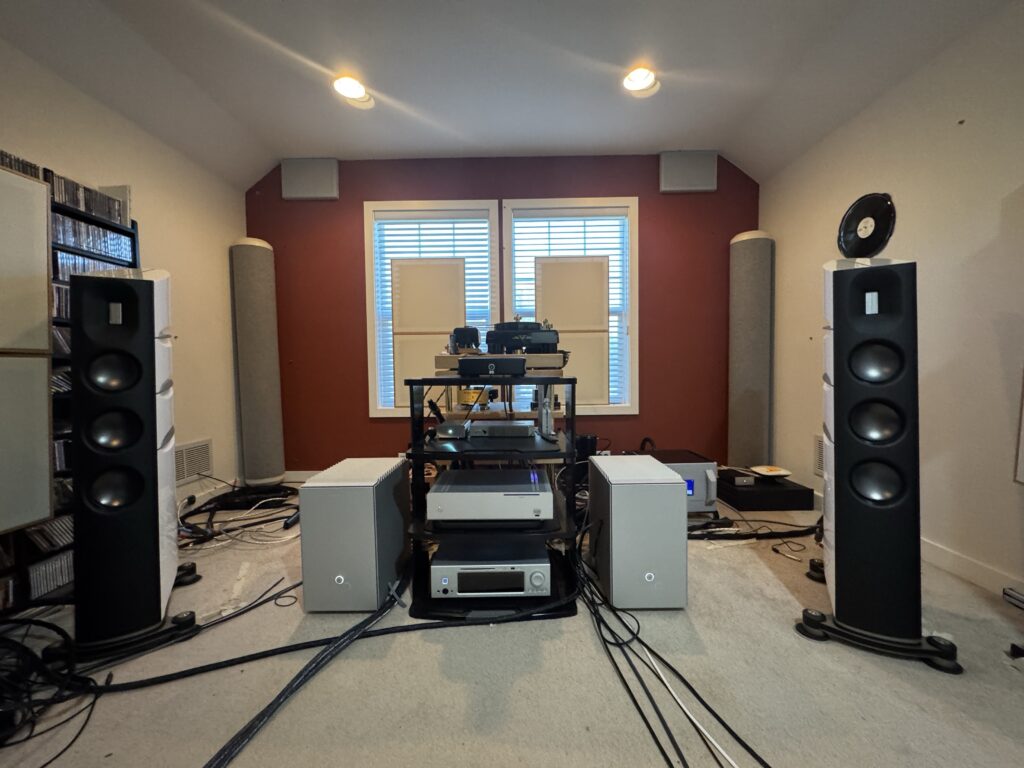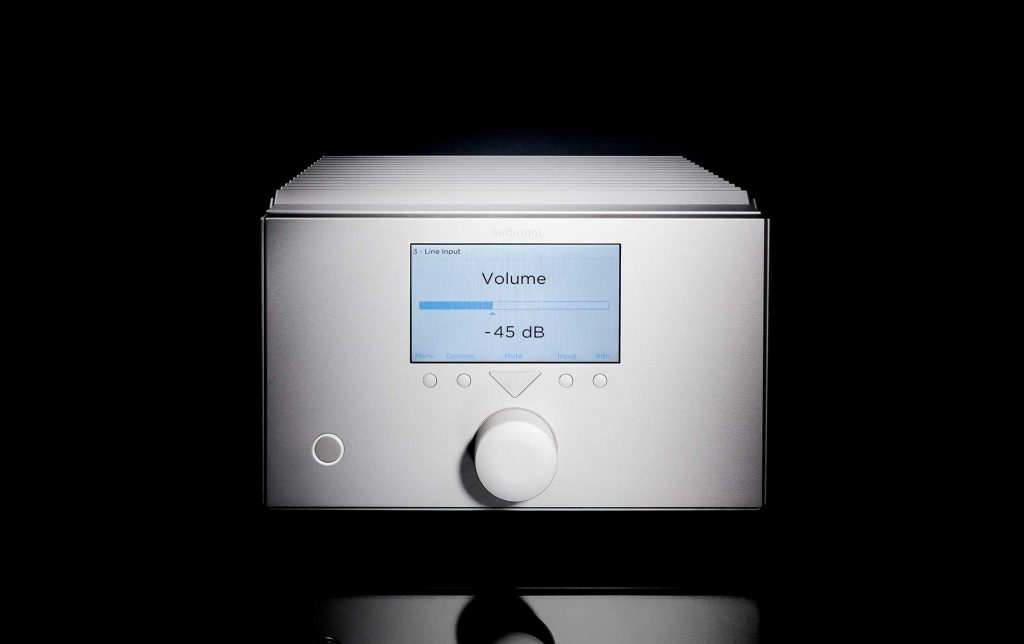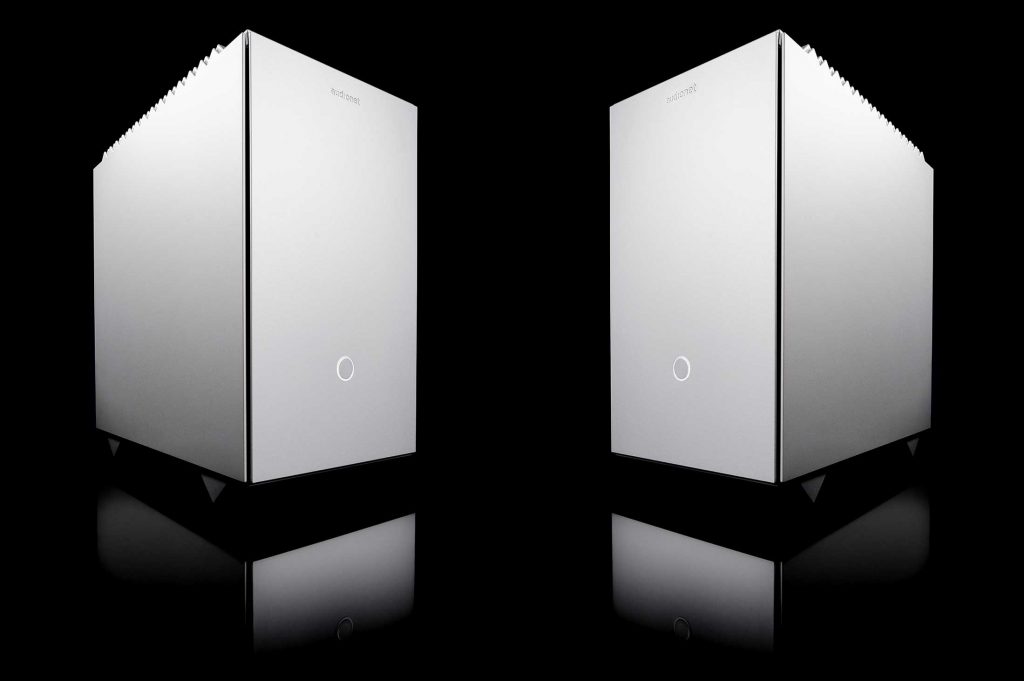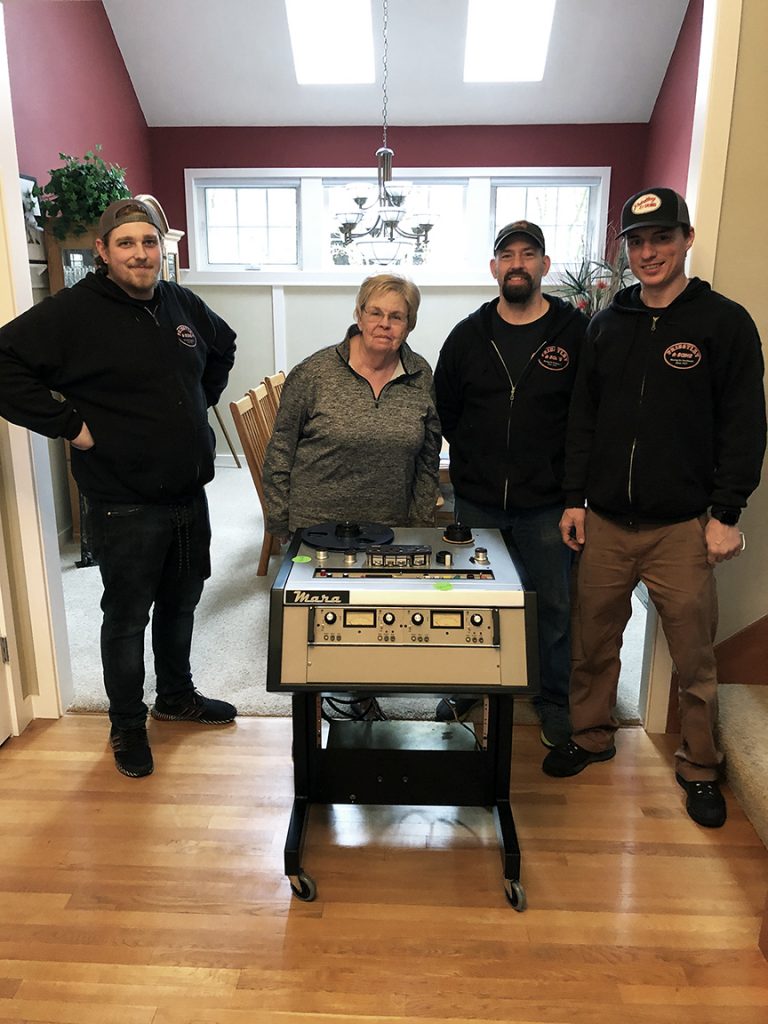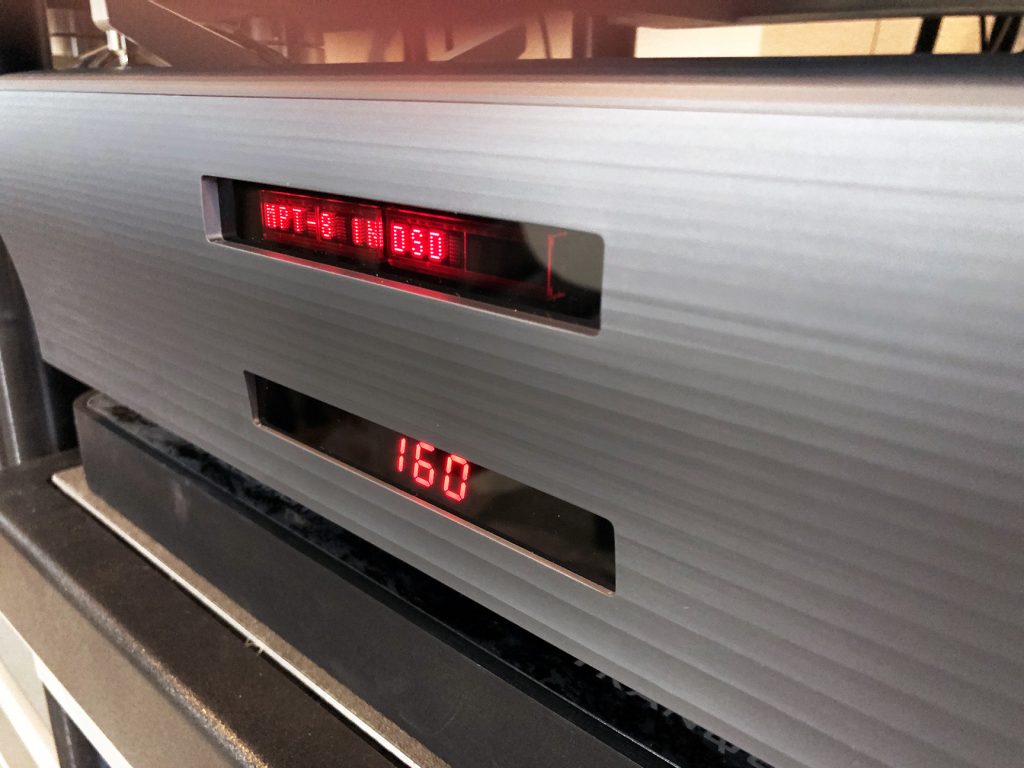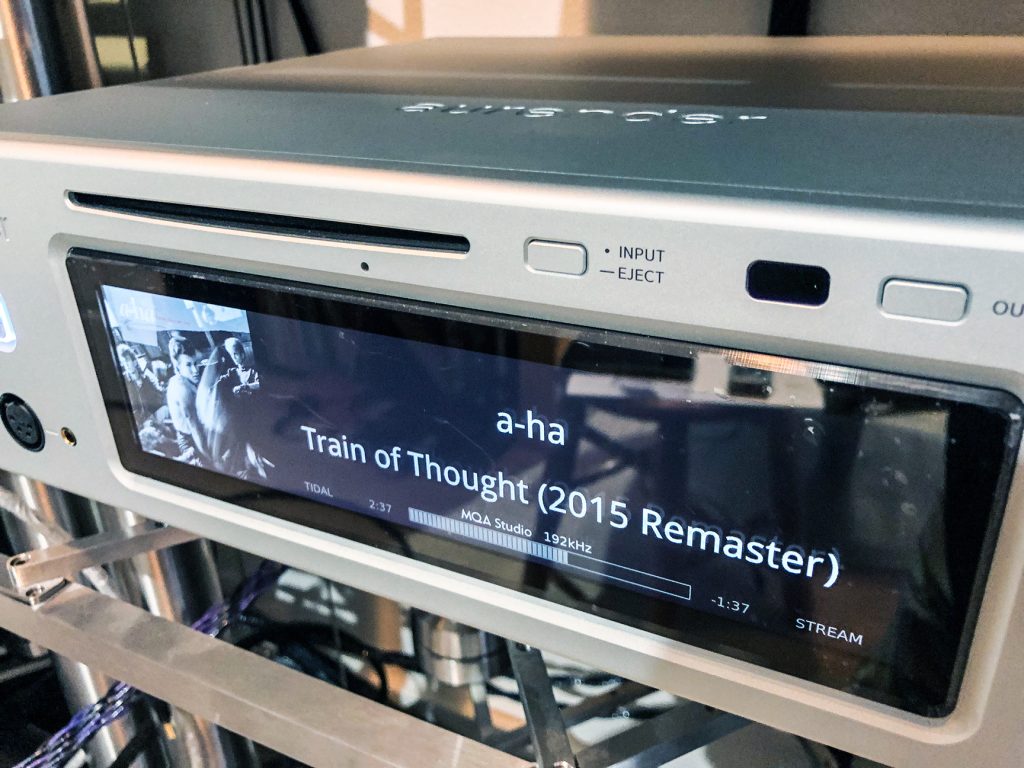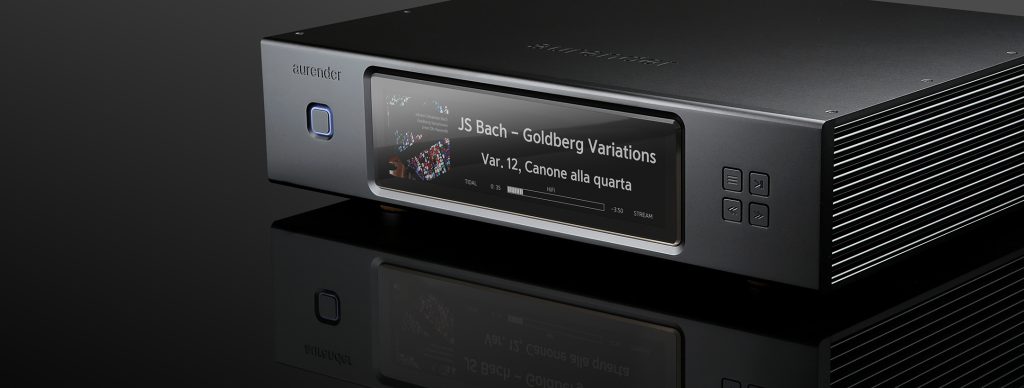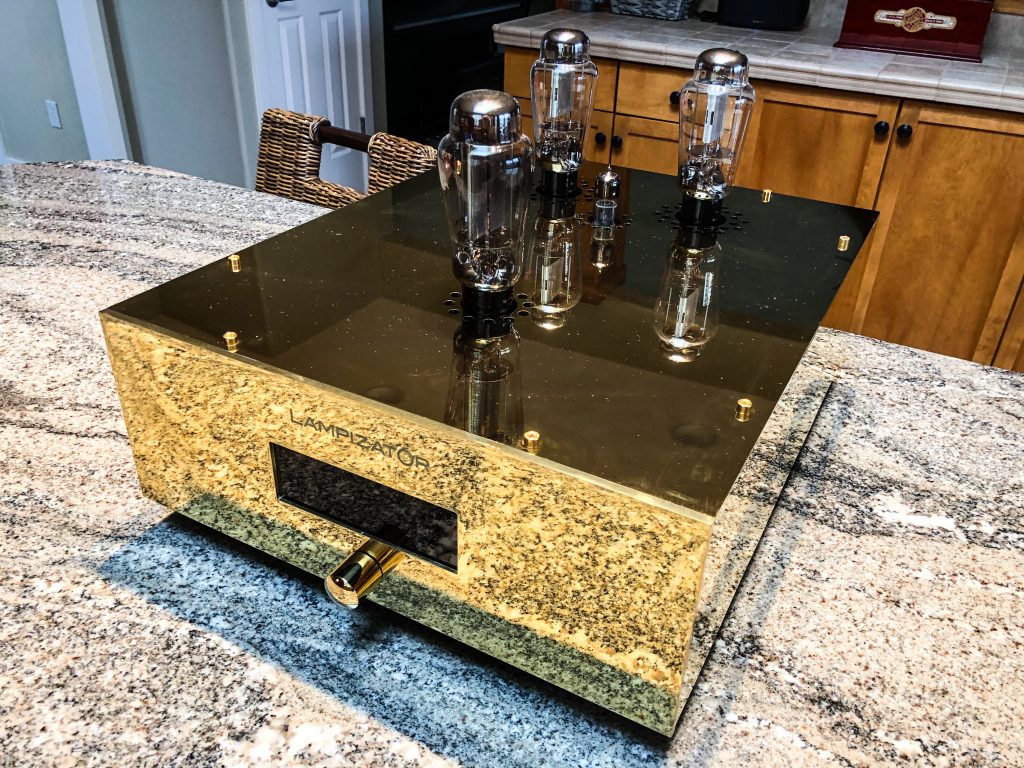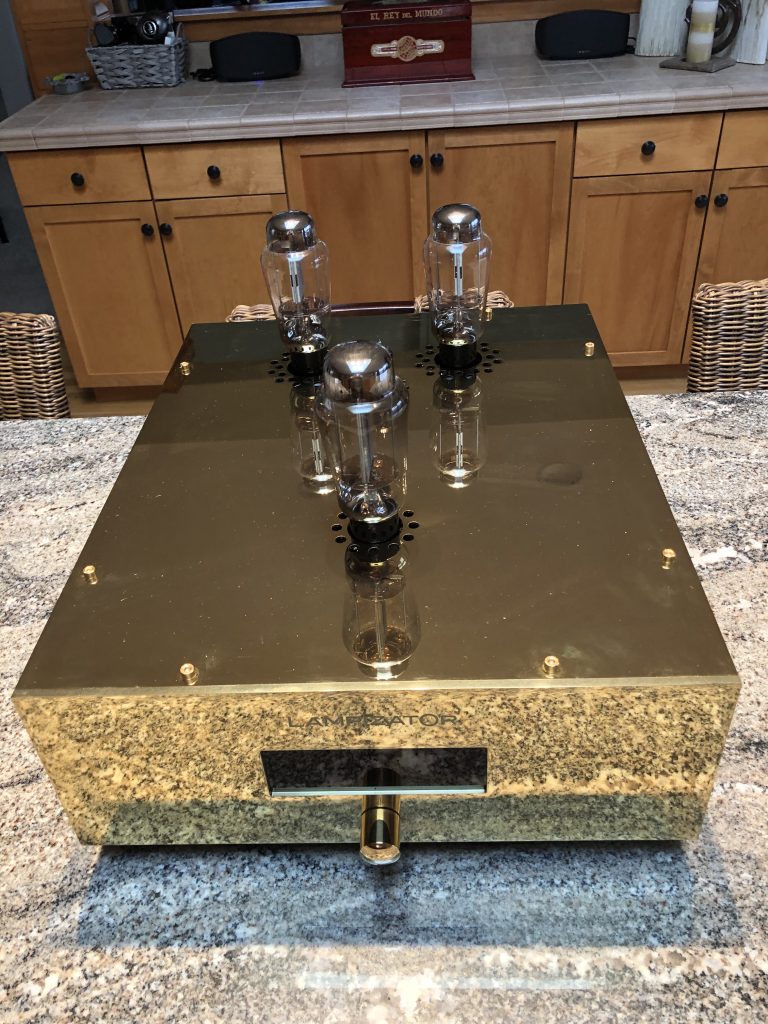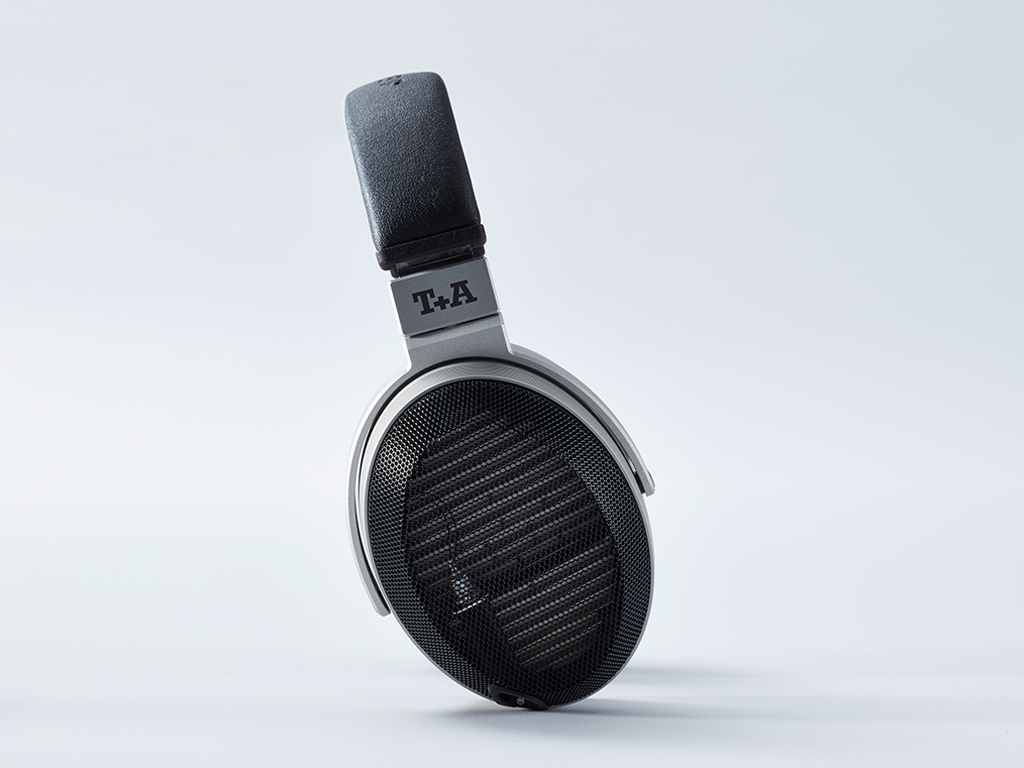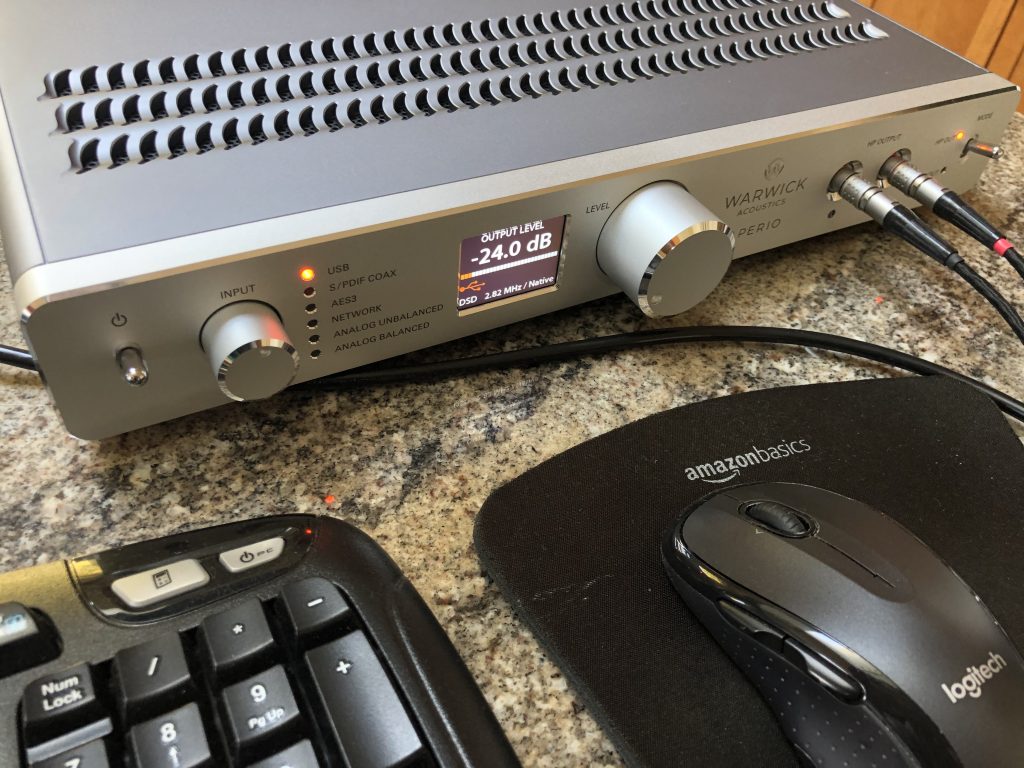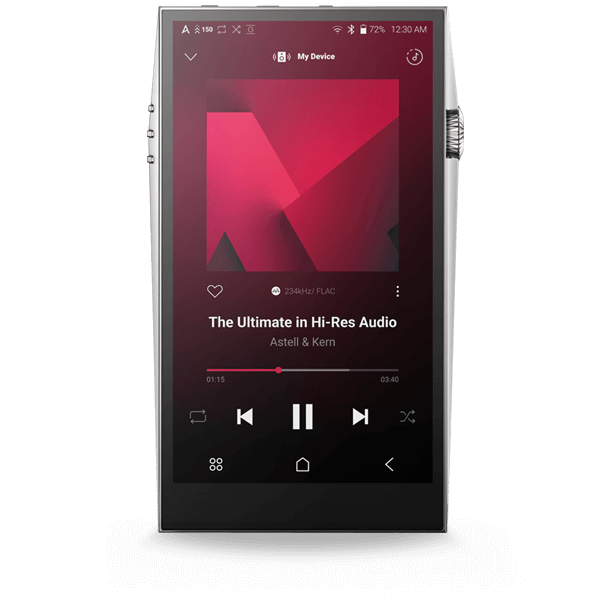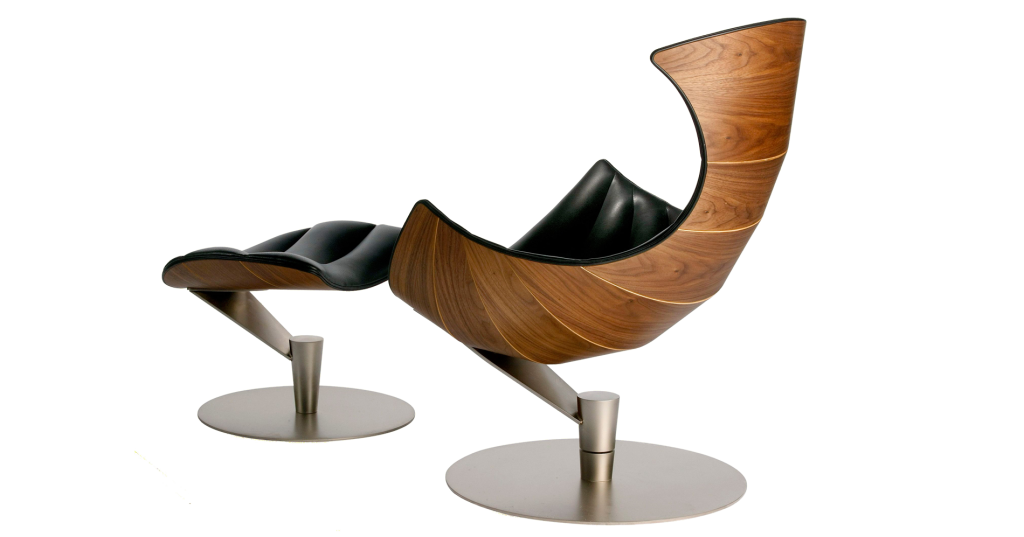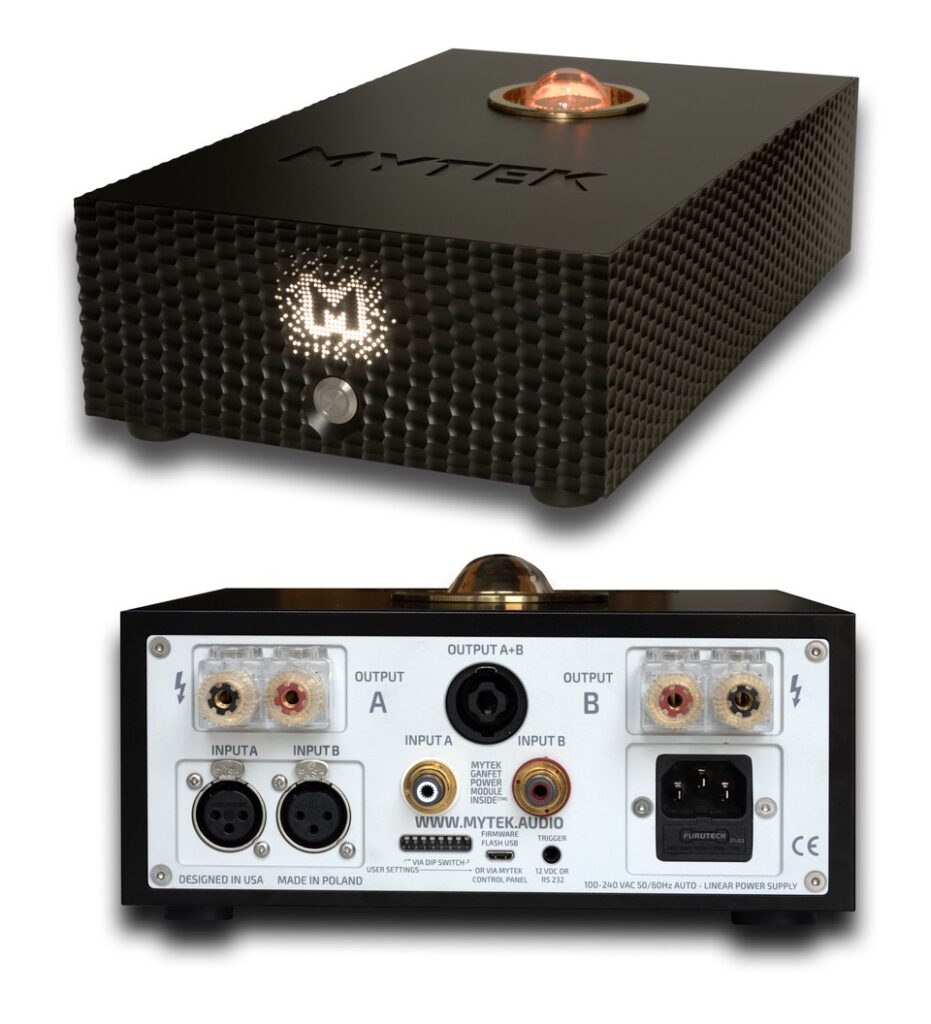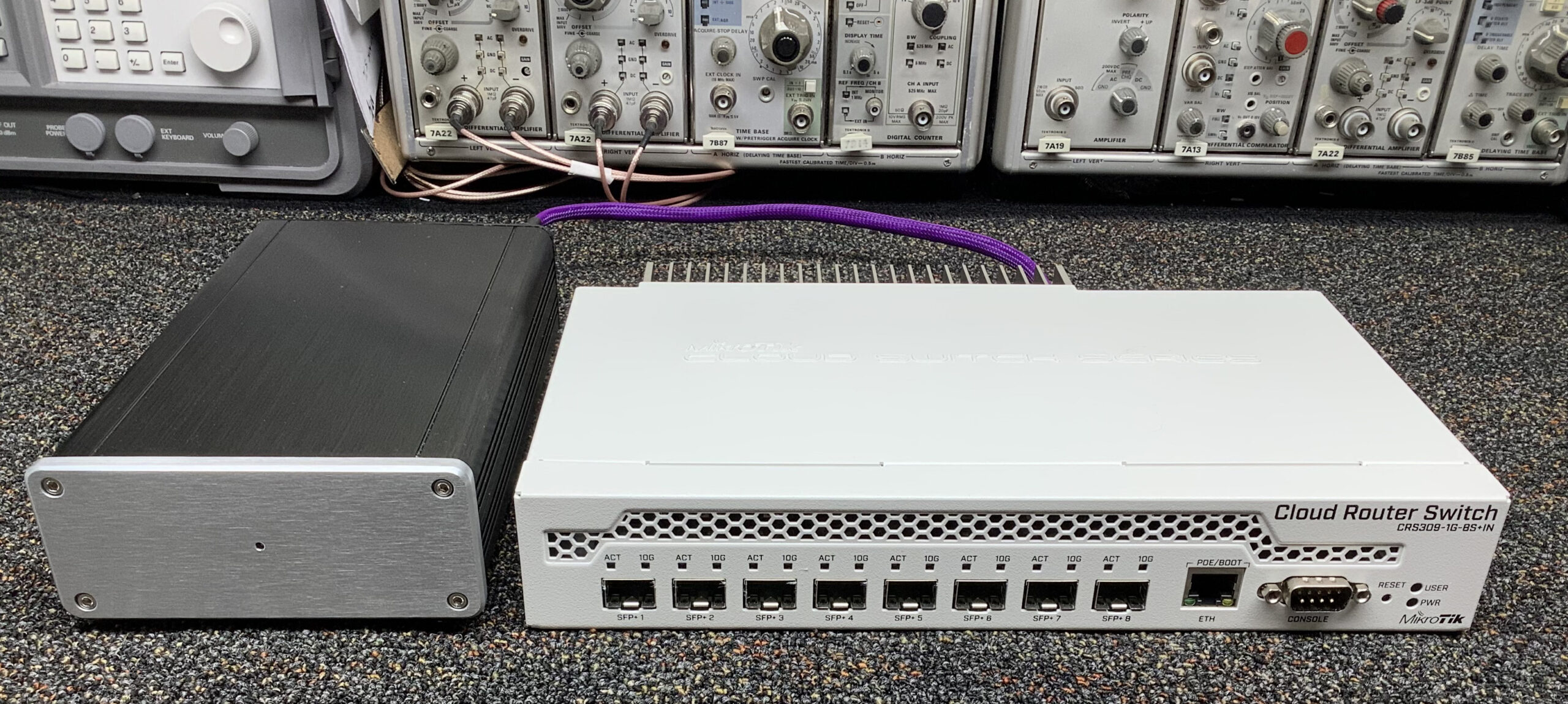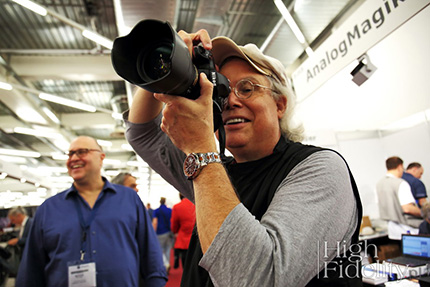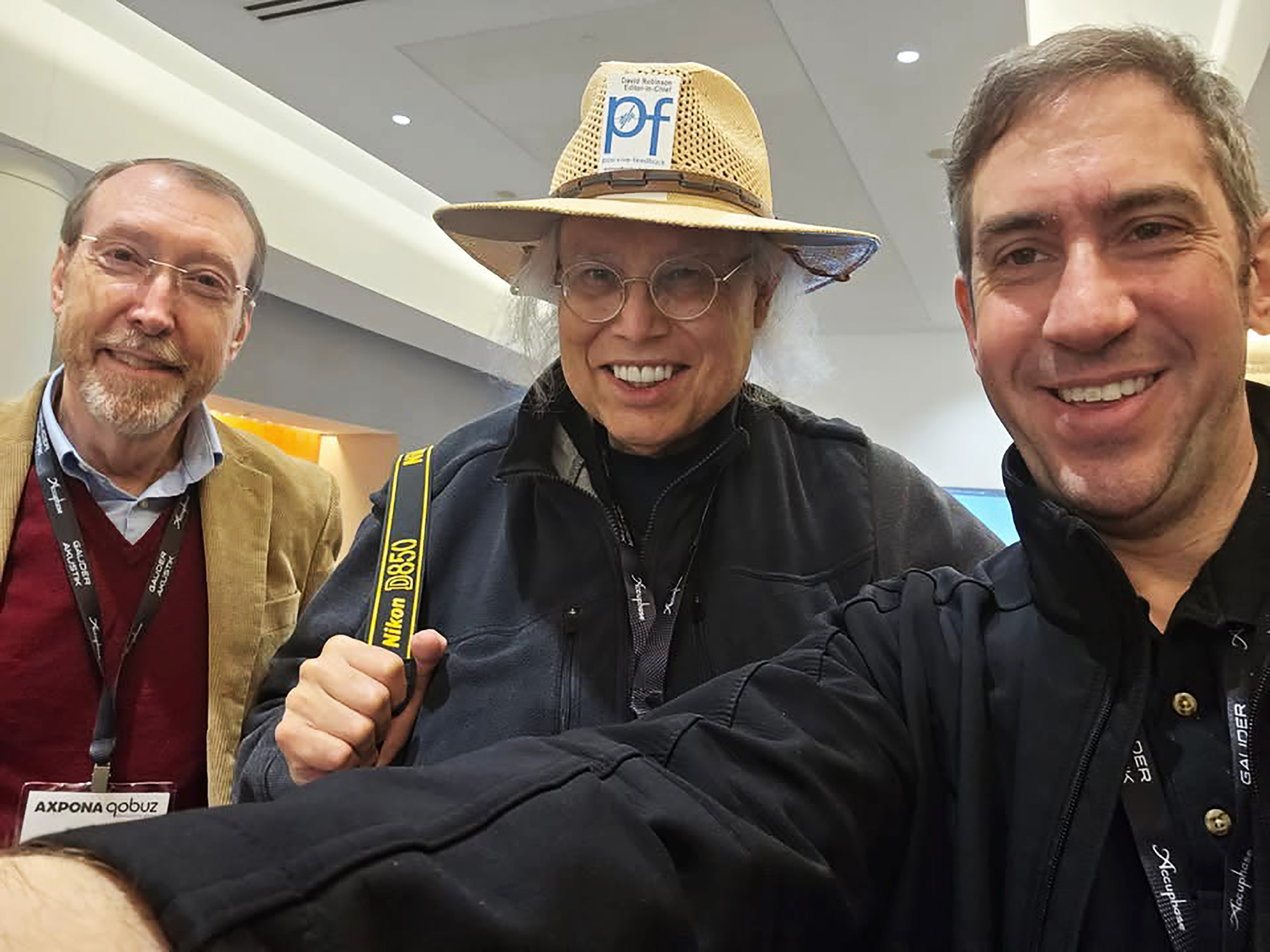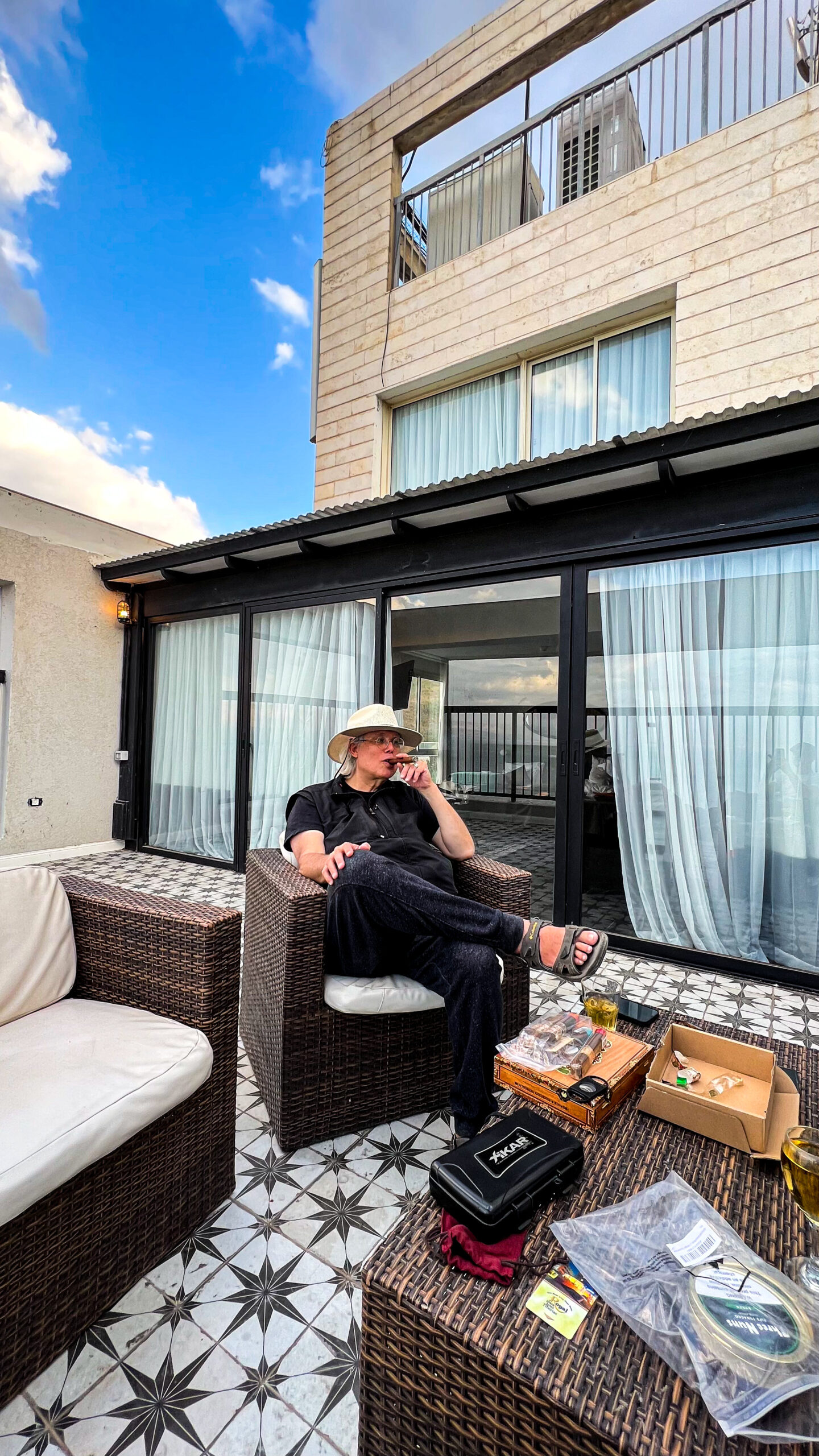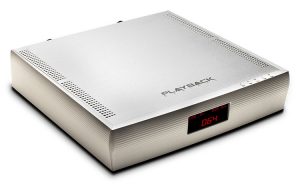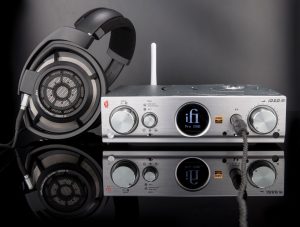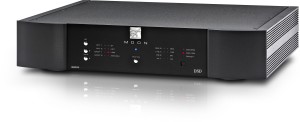
Ye Olde Editor lighting a contemplative stick: a portrait. Spring, 2021, Happy Valley, OR. (Photograph by John Robinson; image processing by Ye Olde Himself.)
The past year…another year of the plague…has been a very tragic time for humankind in general, and quite strange here at PF Central. I've known very many who've been seriously ill with COVID-19 in its various flavors, and not just a few friends and acquaintances who have suffered the sickness all the way unto death. Only the irrational argue that the pandemic is somehow not real…it's as real as a bullet passing just over your head.
In my work here, this has led to many interrupted projects; serious delays in supplying review samples, sometimes for a number of months; and a consequent slip-slidin' away of deadlines to complete my evaluative essays and commentary. C'est la guerre.

Untitled. Painting by Dan Zimmerman.
On the other hand, the strange flow of audio life has allowed me to spend more time with some very fine components, and to experiment with some combinations and synergies. This has been the case with a superb DAC that spent an extended period here in our reference stereo room: The aqua Formula xHD Rev. 2. It was here in our system for much of the year, dropping into place immediately after I had spent quite a while with another exceptional DAC, Ideon's The Absolute, version 1. (Speaking of which, The Absolute has been redesigned completely, and is now The Absolute ε. For more details on this exciting and impressive development, see HERE.)
The main advantages of extended listening to a component are obvious: you have more time to develop a sense of the qualities, audio virtues, and sonic weaknesses of a given design. Certainly, I have done so with this aqua DAC, starting in 2020 (for which it received an initial Brutus Award, detailed for your reference HERE) and up until near the end of 2021. You should read these notes first before proceeding.
I added further reflections on the aqua Formula xHD Rev. 2 DAC in my evaluation of the source component that we used to feed it: the Wolf Audio Systems Alpha 3SX Music Server. It was a key element of the system that I used to evaluate the Wolf Audio Systems music server. In fact, the Alpha 3SX took one of my early 2022 Brutus Awards; you can and should read these notes next. You can find them HERE.
Specifications
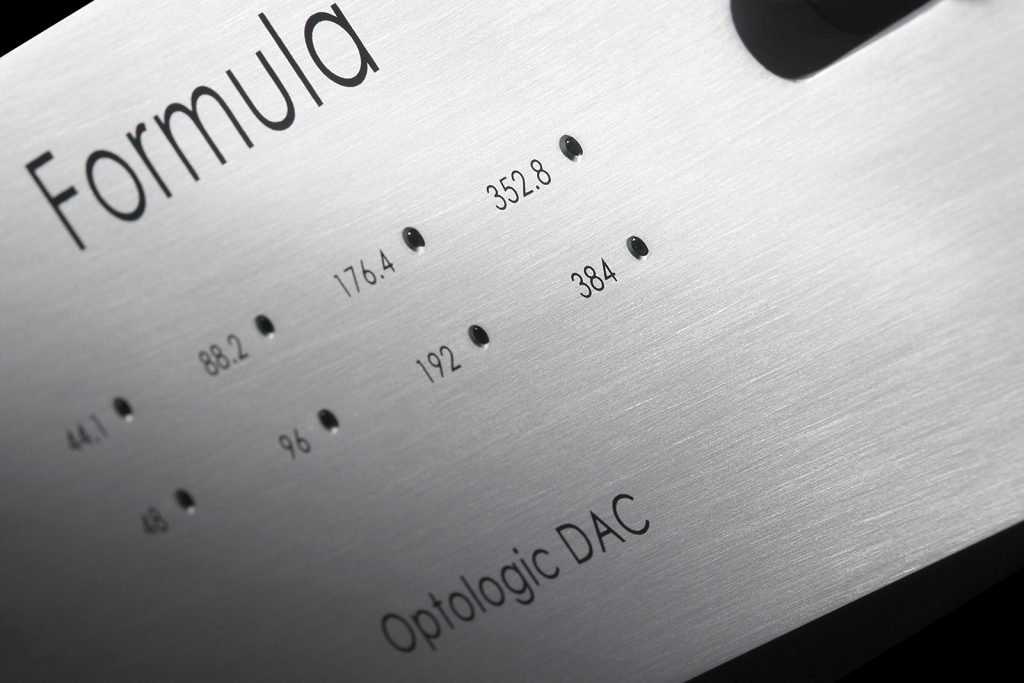
Let's make sure that we have the current scoop on the specs. According to aqua's Web site, this is the technical profile of the Forumula xHD Rev. 2:
- Digital to analog conversion type: Proprietary Optologic D/A conversion system Pure R2R ladder – FPGA (Field Programmable Gate Arrays) based without digital filter
- Supported Native Sample Rates:
- AQlink/I2S serial bus – USB PC Audio: 44.1kHz to 768kHz PCM up to 24-bits;
- DSD64, DSD128, DSD256, and DSD512
- Supports Native DSD via USB and DoP on all inputs
- DAC architecture: Multibit sign magnitude R2R ladder (upgradable)
- Asynchronous USB (High Speed): USB Audio Class 2 with Type B connector
- Digital Receiver: PLL (phase locked loop) technology 128 or 256 FS internally selectable
- AQlink (I2S bus): LVCMOS level
- Oversampling factor: 1x
- Digital inputs – RJ45 AQlink (I2S serial bus) – PCM 24 bit/768kHz; DSD64, DSD128,
DSD256 via DoP- BNC coax (S/PDIF) 75 ohm – PCM 24-bit / 192kHz – DSD64 via DoP
- RCA coax (S/PDIF) 75 ohm – PCM 24-bit / 192kHz – DSD64 via DoP
- AES/EBU balanced 110 ohm – PCM 24-bit / 192kHz – DSD64 via DoP
- USB port – PCM 24-bit / 768kHz – DSD64, DSD128, DSD256, DSD512
- Modular input:
- AES/EBU balanced 110 ohm – PCM 24-bit / 192kHz – DSD64 via DoP
- RCA coax (S/PDIF) 75 ohm – PCM 24-bit / 192kHz – DSD64 via DoP
- AT&T (ST Fiber) – PCM 24-bit / 192kHz – DSD64 via DoP
- Optical TOSLINK – PCM 24-bit / 96kHz – DSD64 via DoP
- Analogue Outputs:
- UNBAL 2 RCA Output 2.4 V RMS
- BALANCED (passive transformers symmetrical) 2 XLR Output : 3.8V RMS
- Output Impedance 10 ohm RCA – 600-ohm XLR
- Load Impedance 10 kohm (min.) RCA – 600-ohm XLR
- Frequency Response 20Hz to 22kHz +0.5dB/-0.5dB
- Phase Response Linear phase
- THD + N 0,016% at 1kHz 0dB
- Main processor STM-ARM microcontroller
- Controls 9 Button on front panel, IR Remote, Isolated RS-232 D-SUB 9-pin connector
- Front Panel Power, phase invert, mute, input switch, RC5 remote sensor
- Power Consumption 100-115V / 220-240V; 50 or 60Hz – 58VA
- Dimensions (W x D x H) 450 x 370 x 100 mm
- Weight 9 kg
- Front finish Satin Aluminum Silver or Satin Black
- Case finish Grey Nextel powder coated
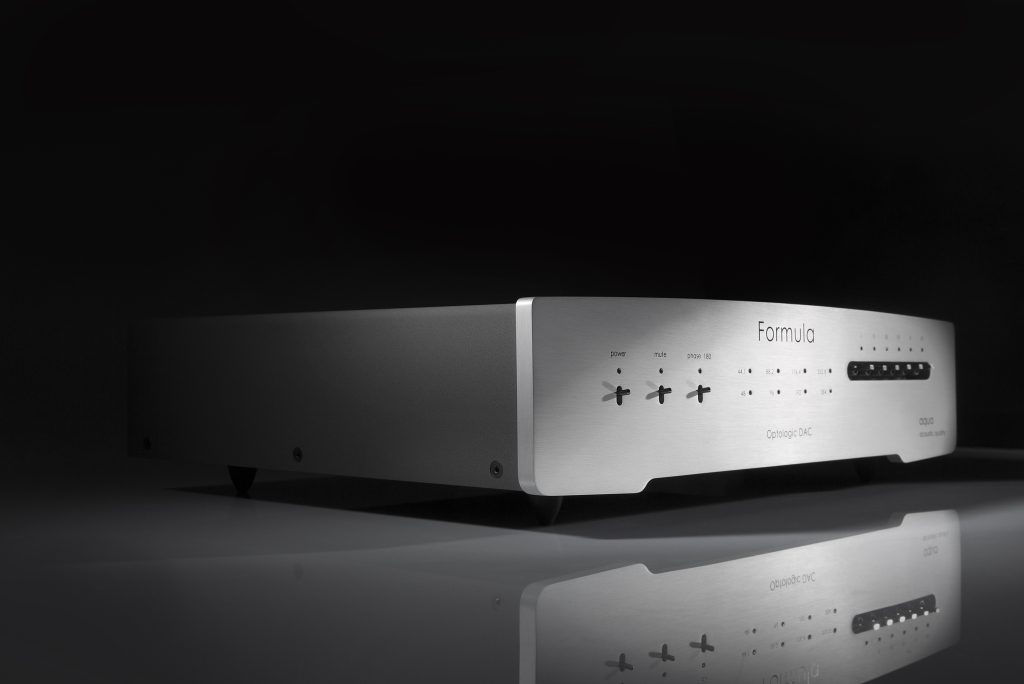
There are some key elements here that I look for in every DAC. First, does it do at least DSD256 (Quad DSD)? Check…and better yet, it does DSD512, which is has become the next level of sine qua non for DACs in my book these days. It also handles PCM up to 768kHz, presumably at up to 32-bit.
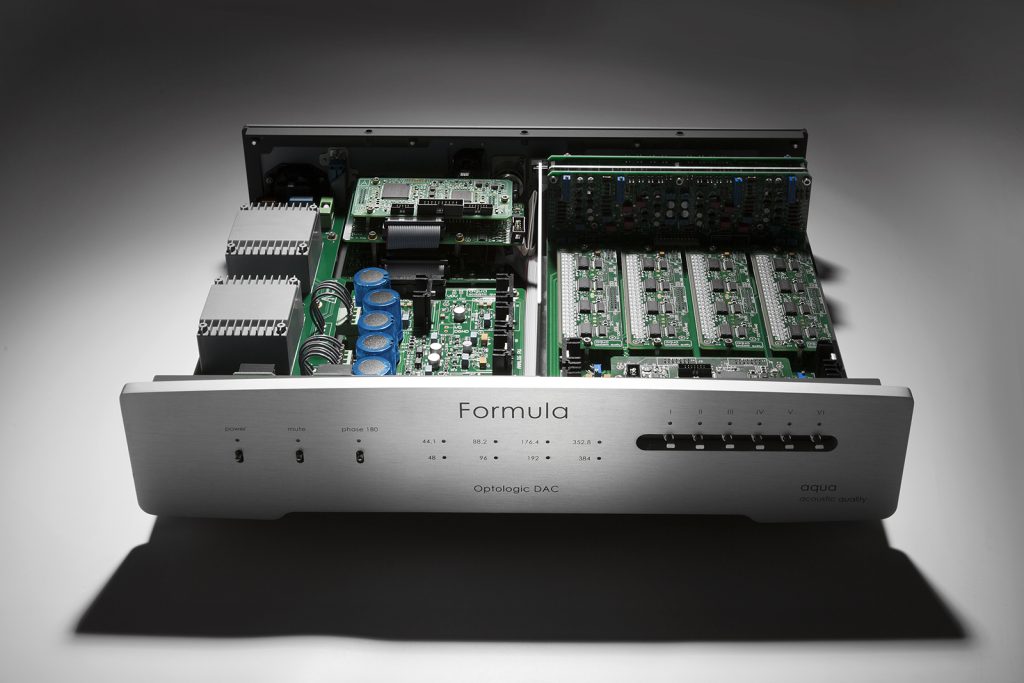
Then there's the combination of Field Programmable Gate Array (FPGA) and R2R (resistor ladder), which, judging by the sonics of this aqua DAC, produces a real audio ambrosia. There are no off-the-shelf delta-sigma converter chipsets here; instead, aqua chose the more difficult path of precisely controlling its extraordinary R2R ladder with its Rev. 2 FPGA. Some of the best audio engineers, e.g., Andreas Koch of Playback Designs and Ted Smith of PS Audio, have been making DACs that employ FPGA in their approach to the D/A conversion envelope. (In fact, both of these designers deal with PCM recordings by undecimating them and converting the results to DSD before further processing…with results that range from very pleasing to truly amazing.)
FPGA then controls the R2R array that aqua uses in its Optologic system, with galvanic and magnetic isolation employed. Two C-Core power supplies are used, one for digital, the other for analog sections. True balanced mode is in play; and the analog section is carefully designed in its parts quality. (Remember that the two key elements in any DAC's design and execution are the power supply and the analog output section. R2R in the aqua implementation is icing on the cake.) To see the full description of the care lavished upon the Formula xHD Rev. 2, see the "Features" section of the product description at https://www.aquahifi.com/formula.html.
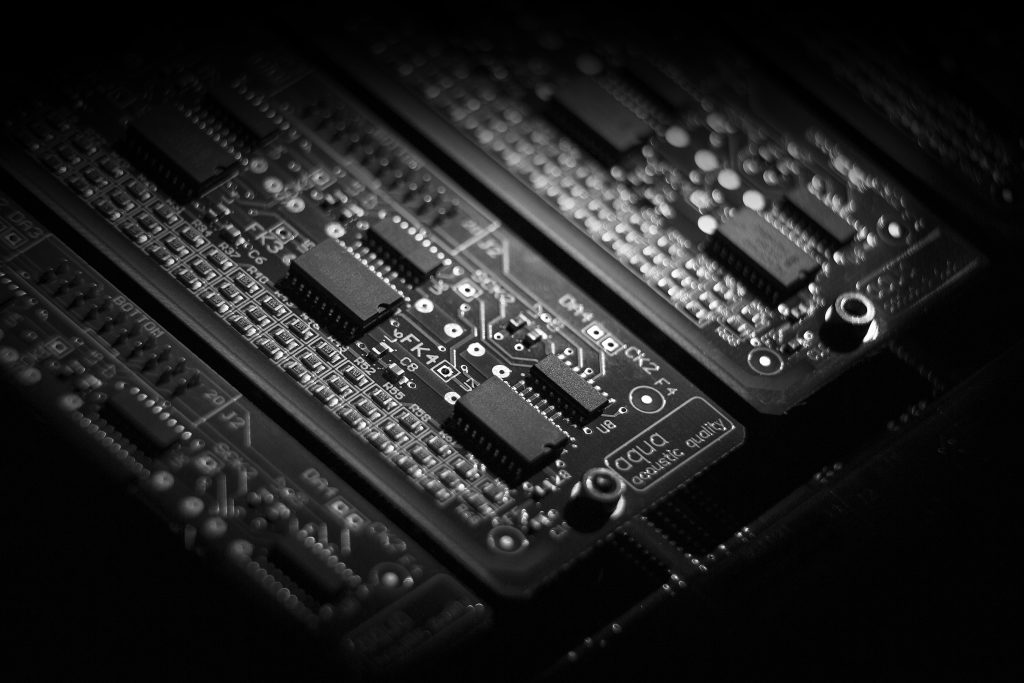
The signal is all direct-coupled in this DAC; no capacitors are in the signal path.
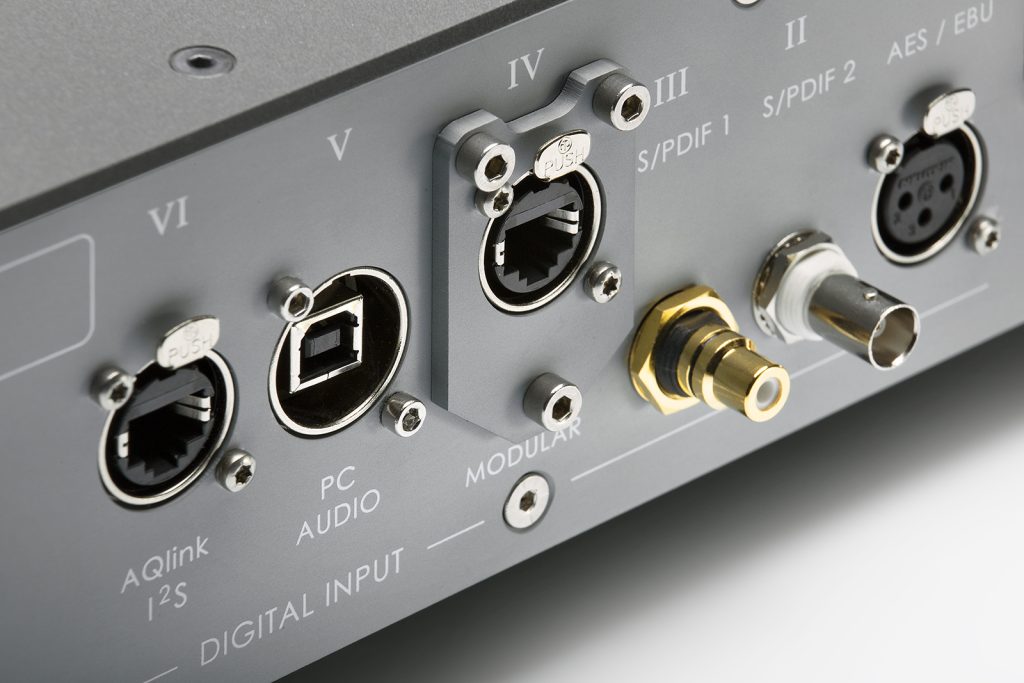
As I noted in previous comments on the aqua, the I/O set on the back of the DAC is a goodly collection of options. I was pleased to see I2S there, together with the more common USB 2.0 on the input side. For the analog output, both balanced and unbalanced are available. For my listening here, we used the balanced outputs exclusively.
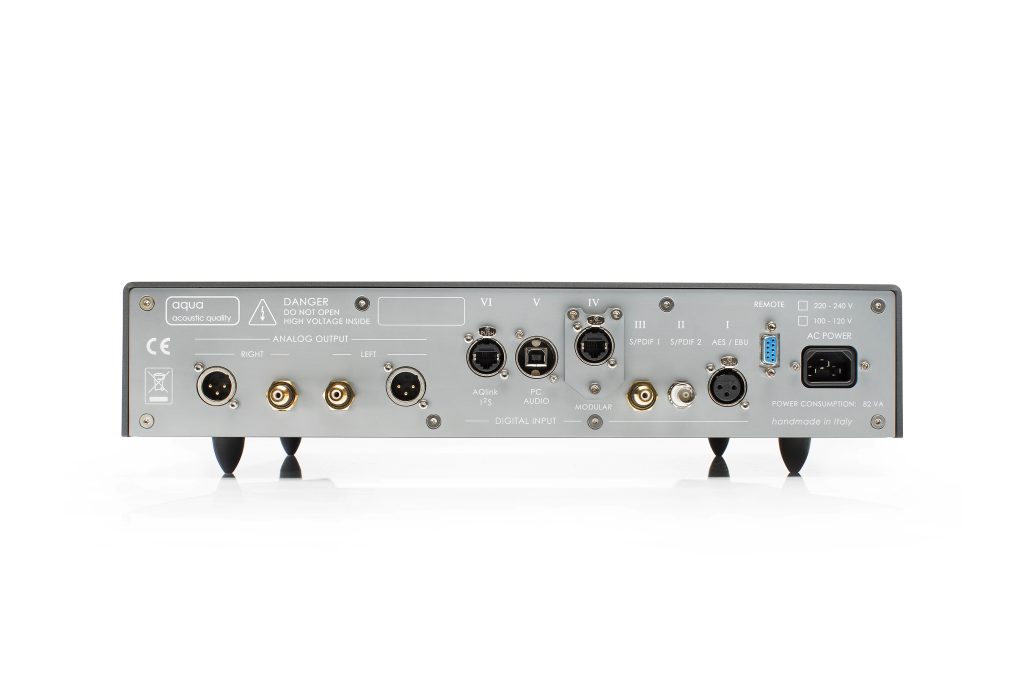
Note that the Formula xHD Rev. 2 uses no digital filtering at all. aqua believes that all such filtering produces anomalous departures from the emotional content of the music, and its ability to connect at the level of soul in the listener. This is an extremely important guiding principle for fine audio design. It don't mean a thing if it ain't got that swing; it's just a big hole if it ain't got that soul.
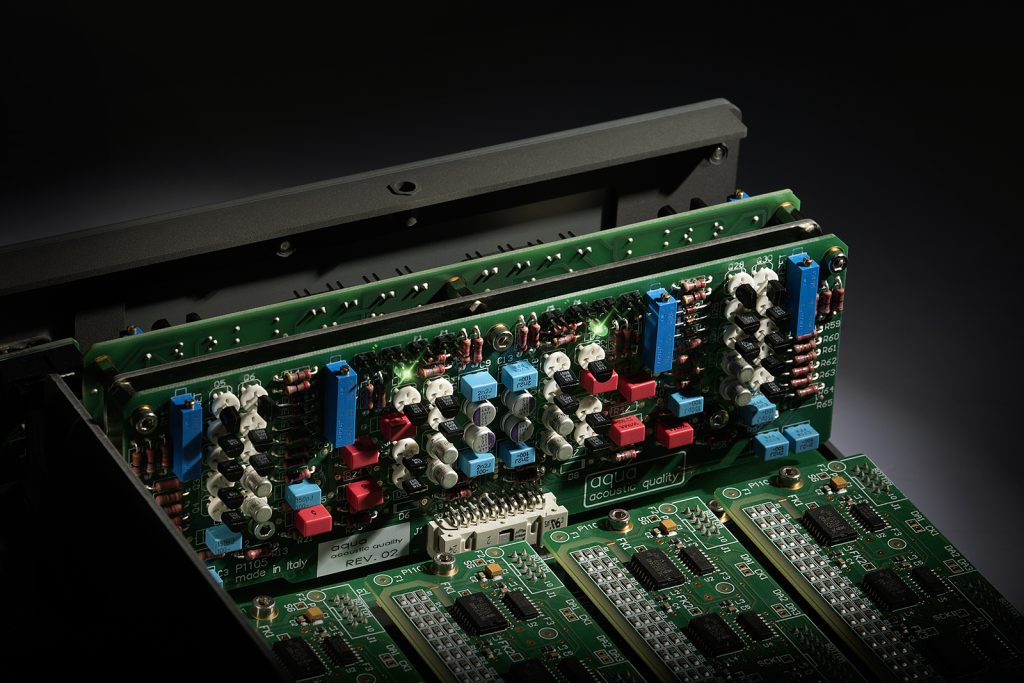
All key circuits reside on their own circuit boards, allowing for maximum modularity when it comes to future enhancements…plug 'n play at its best. No planned obsolescence here.
Overall, as you read the full content of the link above, aqua's self-described "maniacal" attention to detail, and devotion to its design philosophy is quite impressive.
But over time, what have been the sonic results for me?
Reflections on the aqua
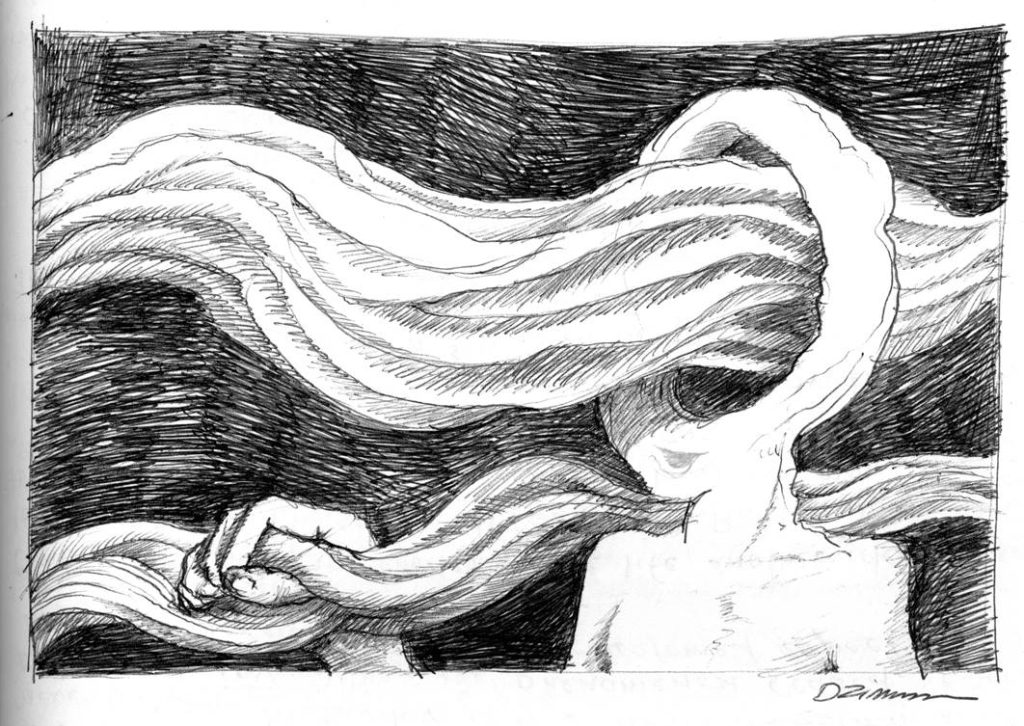
Ghost by the Trail. Drawing by Dan Zimmerman.
Summary of what I've already written.
To do this, I'll quote some of my earlier comments (both http://positive-feedback.com/audio-discourse/impressions-robinsons-brutus-awards-for-2020-part-the-third/, and http://positive-feedback.com/audio-discourse/wolf-audio-alpha-3sx-music-server/, and flesh them out with my further extended listening experiences with this DAC.
First, a reminder of the supporting actors, for context's sake:
"My evaluation chain included the Wolf Audio Systems Alpha 3SX streamer/music server with its optimized JRiver Media Center as the playback system, being fed by the QNAP 1273U NAS with RAID 5 with 84 TB of effective storage (after subtracting for RAID 5 overhead). Joe Parvey of Wolf Audio Systems was able to remote in for the installation and tweaking of the aqua driver in Windows 10. With many terabytes of music storage, it was easy to try quite a lot of DSD and PCM, even in the more limited time that I had in the final season of the year for the 2020 Brutus Awards.
The cabling was as it was for Ideon's The Absolute (Merrill Audio and Synergistic Research), Walker Audio's Velocitor (latest revision), with the same Critical Mass Systems double-wide rack system and filtering shelves. Nothing to complain about there."
The other electronics and loudspeakers:
- "Merrill Audio Christine Preamp
- Merrill Audio Element 118 Monoblock Amps
- Cabling by Kubala-Sosna and Synergistic research (in succession)
- Synergistic Research PowerCell SX
- Isolation stands by Critical Mass Systems and YG Acoustics (in succession)
- VIVID GIYA G1 S2, Raidho TD 3.8, and YG Acoustics Sonja 2.3i loudspeakers"
My initial take on the Formula xHD Rev. 2 was quite favorable, as I noted when I gave it one of my Brutus Awards for 2020:
"Once we had the setup completed and the drivers loaded, the Formula xHD Rev. 2 performed like a champion. I don't know if this review sample had much time or burn-in on it, but right out of the box it showed that it belonged in the first rank of DACs. I was taken by its sense of presence, its presentation of detail without being "analytical" or cold, and its ability to handle huge swings in dynamics. The no filtering/no oversampling plus FPGA is showing itself to be a powerfully credible approach to digital sound reproduction…I'm very impressed."
In January of this year, I published my review of the Wolf Audio Systems Alpha 3SX. In it, I briefly updated my take on the aqua DAC:
"Since I have final notes on it coming out shortly, I'll reserve my specific observations about its audio virtues for that article. Nevertheless, I can say that the Formula xHD Rev. 2 is a top-notch performer, providing a silky, elegant, and nicely transparent presentation, regardless of source or genre. The dynamics are fantastic, too."
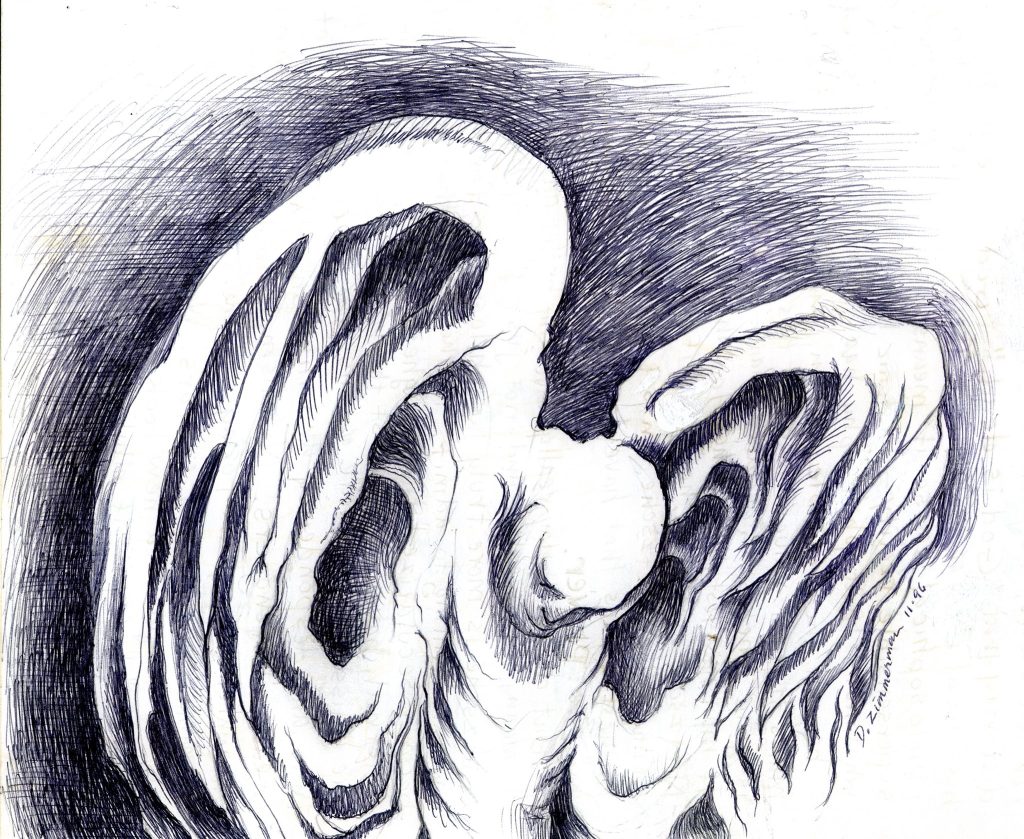
"The Angel Who Listens." Drawing by Dan Zimmerman, 1996.
Given my prior experiences, I would finish out and fill in with these final notes.
First, the Formula xHD Rev. 2 impressed right out of the box. As I noted earlier, I don't know if aqua had a lot of break-in…the review unit may have been at another reviewer earlier, as I recall…but the sonics were superb from the get-go.
The synergy between the Formula xHD Rev. 2 and the Wolf Audio Systems Alpha 3SX Music Server was outstanding. Furthermore, the transparency of the Merrill Audio Christine Reference Preamp + Element 118 monoblocks sounded like these designs had all come from the same general audio clan, regardless of the loudspeakers that we used. I've spoken several times about the virtues of the Merrill Audio reference designs. In all cases, the extremely sonic transparency of the Merrill gear is a two-edged sword. Good stuff is shown in glory; mediocrity is mercilessly revealed. The aqua DAC passed with flying colors.
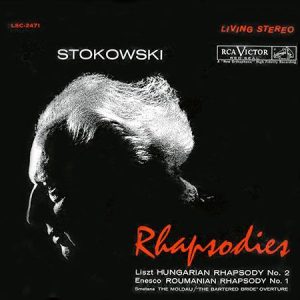
The sense of presence of the aqua Formula xHD Rev. 2 was…to use an audiophile term that has too often been driven into the ground: "palpable." All DSD playback was simply there in the room…especially with DSD256 and DSD512. Regardless of the source recording, imaging and soundstaging were rock solid and well delineated, without drifting over into the realm of the etched or, worse yet, the dreaded kingdom of Queen Anna Lytical. For example, listening to our DSD64 rip of the SACD of Stowkowski Rhapsodies from Analogue Productions, a very longtime reference for imaging and soundstaging (and don't let me forget dynamics and the growly richness of orchestral strings!) was enough to make me smile…and keep me smiling.
Transparency. The king of audio virtues in my book. The Merrill Audio Christine/Element 118s have this in spades, and would be devilishly unforgiving of any veiling that a given recording tried to get away with.
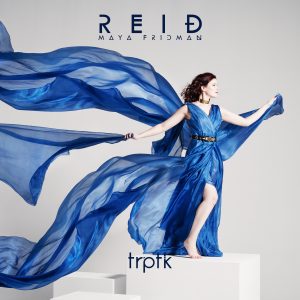
Flying colors here. For example, Maya Fridman's stellar Reid in DSD512 from TRPTK and distributed by NativeDSD.com was brilliant, and simply sang via the Formula xHD Rev. 2.0. The DSD512 There is a very clear articulation of the strings; the opening dialog between the synthetic bell-like notes and the cello in "Light is Calling" is haunting…not surprising, since its composer, Michael Gordon, wrote it in the aftermath of 9/11, an event that occurred while he was in NYC. (BTW, if you haven't heard DSD512 yet, you really should experience it.)

The ease and naturalness of aqua's DAC was extremely relaxing. Recordings were breathing, which meant that I could, too. I was able to lean back and just take in the music on albums like the transfer to DSD128 of Alan Parson Project's I Robot, Alison Krauss' Now That I've Found You, also to DSD128. Or the recording straight to DSD256 of Fiona Boyd Hawkins' and Rebecca Daniel's ravishing Heavenly Voices from Blue Coast Records. Good for the soul…and the Formula xHD Rev. 2 DAC did an exceptional job of delivering the recording—which I've heard in various systems here with assorted DACs—in a world-class way.
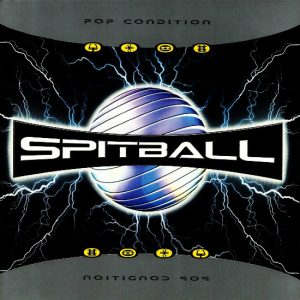
Dynamics? Try the ultra-rare Spitball Pop Condition, ripped from SACD to DSD64. But do keep the volume down…with the Formula xHD Rev. 2 in place, your speakers will be at risk otherwise.
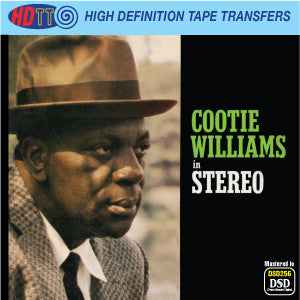
And for big-band jazz, it's hard to beat the DSD256 of Cootie Williams in Stereo from HDTT. Sweet, wonderfully produced and recorded…Bob Witrak of HDTT did audiophiles and music lovers every a very big favor when he reissued this lovely transfer from RTR tape. Don't have it? Get it!
Final verdict
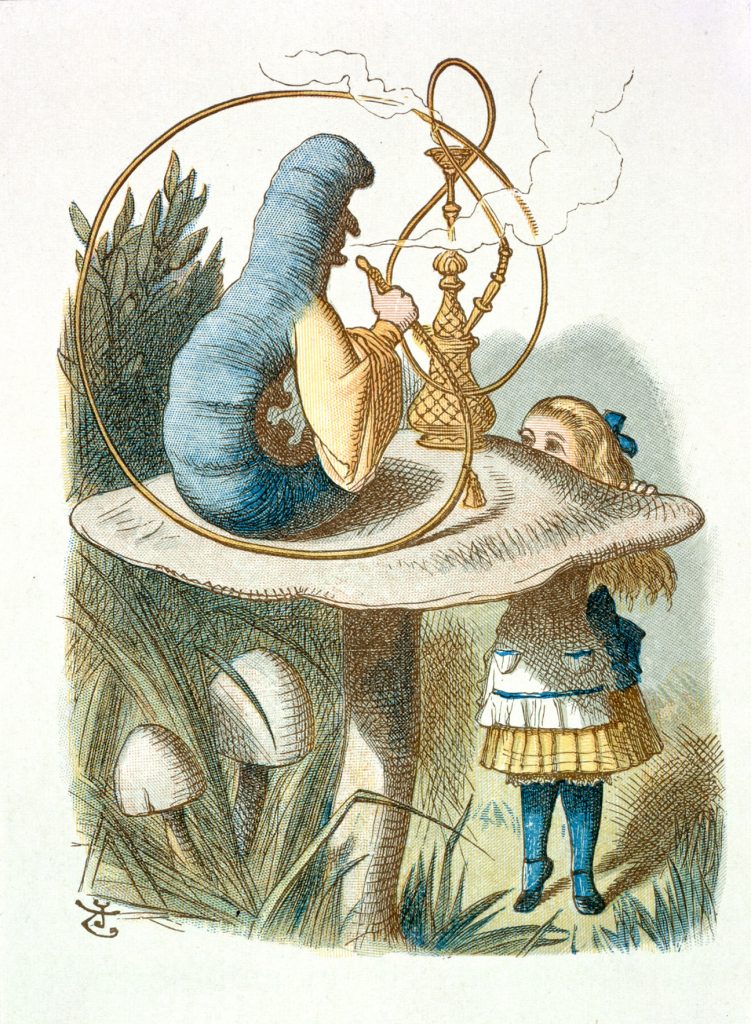
I could go on, but diminishing returns being what they are, it's time to stop.
In my estimation, the aqua Formula xHD Rev. 2 is one of the relatively rare, front-rank, world-class DACs…and I've heard a fair number of them over the years. The additional time that I took with the Wolf Audio Systems Alpha 3SX/aqua Formula xHD Rev. 2 allowed me to fill-in my impressions over a much longer stretch than I might have otherwise have had.
In each case, with every genre of music that I essayed, the Formula xHD Rev. 2 came up golden, and rewarded me with very many hours of exceptional listening. This went all the way until late November of 2021. That's why I am taking the unusual step of extending its Brutus Award status early in 2022.
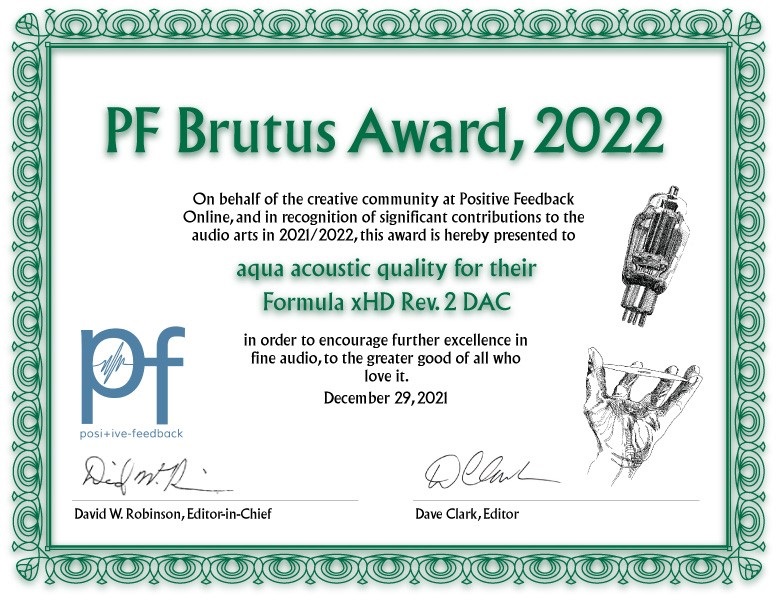
If you can handle this price range for a true reference-level DAC, you will find the aqua Formula xHD Rev. 2 DAC to be worth very serious consideration, and a determined listen. It's definitely on my top o' the heap list….
Price: USD $18,600
aqua
Milan, Italy
North America Distributor
Scott Wylde, Arcadia Audio Marketing
416 994 5571




